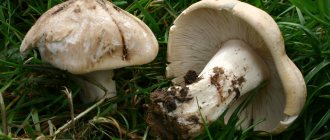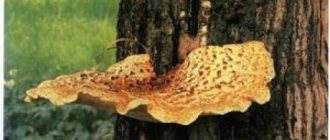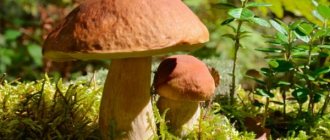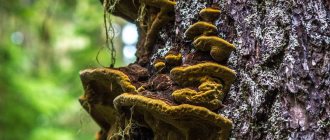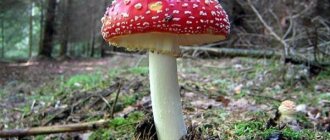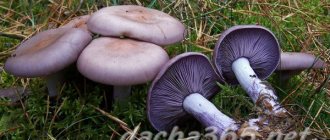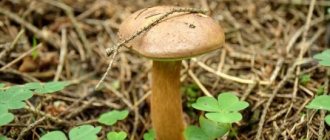All cap mushrooms are classified into tubular and lamellar. As an example of tubular mushrooms, we can cite such well-known species as boletus mushrooms, tinder fungi, oak mushrooms, flywheel mushrooms, boletus mushrooms, boletus mushrooms and many others. As a rule, in most varieties of tubular mushrooms the flesh turns blue when cut, but this does not affect their taste in any way.
Tube mushrooms growing on trees and dead wood
Lacquer tinder fungus (Ganoderma lucidum)
Family: Ganodermataceae
Season: July - November
Growth: in groups
Description:
The leg is lateral, uneven and very dense.
The hymenophore is ocher, consists of short tubes with small rounded pores.
The cap is flat, shiny, uneven. The surface of the cap consists of concentric growth rings of different shades.
The pulp is woody, ocher in color.
This tubular mushroom is inedible; used to treat a number of diseases.
Ecology and distribution:
This is a tubular mushroom that grows on the base of weakened and dying trees, as well as on dead wood of deciduous trees. In Russia, it is distributed in the Stavropol and Krasnodar territories, in the North Caucasus.
Biennial dryweed (Coltricia perennis)
Family: Hymenochaetaceae
Season: early July - November
Growth: in groups
The cap is dry, leathery, with golden-brown or brick-red concentric circles. The tubular layer is slightly descending, finely porous, brownish.
The leg is narrowed, often with a nodule, velvety, matte, brown.
The pulp is leathery-fibrous, brown, rusty in color.
Inedible.
Ecology and distribution:
Grows in coniferous and mixed forests, often on sandy soils, in fires.
Chestnut polypore (Polyporus badius)
Family: Polyporaceae
Season: mid-June - November
Growth: in groups
Description:
The pulp is leathery, very dense, whitish. The edge of the cap is uneven and wavy.
The leg is central or eccentric, strongly narrowed towards the base, hard, whitish, half-limited by a dark velvety zone.
The cap is funnel-shaped, thin, light ocher, yellow-brown or red-brown. The tubular layer is very finely porous, descending onto the stalk, white or cream, and turns yellow when pressed.
Inedible due to hard flesh.
Look what this tubular mushroom looks like in the photo:
Ecology and distribution:
It grows on stumps, in forests, in parks, on dead wood of deciduous trees (birch, oak, alder, linden). Rarely does this trumpet mushroom grow on living trees. Prefers damp places. Occurs frequently and abundantly.
Next, you can see photos and names of tubular mushrooms that turn blue when cut.
Effect on bark and roots
The trunks of old trees are most often infected by parasitic fungi, which with age can lose the ability to form a wound core that protects the plant from the penetration of fungal spores. The wood-destroying fungus causes great damage not only to forests, but also to fruit plantings in household plots.
Parasitic fungi most often affect poplars, oaks, willow, linden and birch, as well as cedar plantings, pine, walnut wood, maples and chestnuts. Larch and spruce wood are affected somewhat less frequently. The development of mycelium of polypores on walnuts may be observed. As a result of this relationship, red-brown destructive stem rot and red-brown prismatic core rot are formed.
The core parts of the trunks are predominantly affected. Some fungi, called parasites, suck out the nutrients necessary for life from the roots of a tree through special threads. The parasitic fungus can have a variety of colors : grayish-white, dark brown, orange and even blue-black, but the destructive role of such species is obvious. The plant supplies the parasitic fungi with food for a long time, after which it dies. However, it is the polypores that perform the function of forest health workers and not only decompose old and diseased wood, but also enrich the forest soil with basic nutrients.
Tubular mushrooms that turn blue when cut
Beautiful boletus (Boletus calopus)
Family: Boletaceae
Season: July - October
Growth: singly or in small groups
Description:
The cap is hemispherical, later convex. The skin is matte, dry, brownish-brown in color. The tubular layer is yellow, the pores are rounded, small, and turn blue when pressed.
The pulp is whitish or light cream, sometimes turns blue when cut, and tastes bitter.
The leg is initially barrel-shaped, then club-shaped, the color is lemon-yellow with a white mesh on top, carmine-red with a red mesh in the middle, and brown-red below.
Inedible due to unpleasant bitter taste.
Ecology and distribution:
Grows in coniferous, oak and deciduous forests. Prefers acidic sandy soils. Distributed in Europe and the south of the European part of Russia.
Speckled Oak (Boletus luridiformis)
Family: Boletaceae
Season: mid-May - October
Growth: singly or in small groups
Description:
The skin is velvety, matte, occasionally slimy, brownish-brown, and darkens or turns black when pressed. The cap is hemispherical, later cushion-shaped.
The pulp is yellowish, quickly turns blue when cut, and brownish in the stem. The tubes are yellow-olive, the pores are rounded, small, yellow, later turn red, and turn blue when pressed.
The leg is barrel-shaped, later club-shaped, yellow-red in color, without a reticulate pattern, with red scales.
Conditionally edible mushroom. Used fresh (after pre-boiling) or dried.
Ecology and distribution:
A tubular mushroom called speckled oak fungus forms mycorrhiza with beech, oak, spruce, and fir. Grows in forests and swampy areas, among mosses, prefers acidic soils. In Russia it is found in the Caucasus, Eastern Siberia, less often in the European part and Western Siberia.
Olive brown oak (Boletus luridus)
Family: Boletaceae
Season: July - September
Growth: singly or in small groups
Description:
The pulp is yellowish, dense, reddish at the base of the stem, turns blue when cut, then turns brown. The skin is velvety, slimy in wet weather, the color varies from light brownish-yellow, darkens when touched.
The cap of this tubular mushroom is hemispherical or convex, rarely flat. The tubes are free, yellow, later greenish; The pores are round, very small, reddish, and turn blue when pressed.
The leg is club-shaped, yellow-orange, with a convex brownish-red mesh pattern.
Conditionally edible mushroom. Raw or undercooked can cause poisoning.
Ecology and distribution:
Grows in deciduous and mixed forests on calcareous soils, mainly in bright, well-warmed places by the sun. Distributed in Europe, the Caucasus, rare in Western Siberia and the south of the Far East.
Polish mushroom (Boletus badius)
Family: Boletaceae
Season: June - November
Growth: singly or in rare groups
Description:
The cap of young mushrooms is semicircular, later it becomes cushion-shaped.
The leg is fibrous, brown or yellow with red-brown fibers, lighter at the top and bottom.
The pulp is dense, yellowish; It turns slightly blue on the cut, then turns lighter in the cap and turns brown in the stem. The tubes turn blue when pressed. The skin is brown, does not come off, is smooth to the touch, a little sticky in wet weather. Tubular layer with a small notch at the stem, yellowish on the stumps.
A good edible mushroom.
Ecology and distribution:
It forms mycorrhiza with pine, less often with other species. This is a tubular mushroom that grows in coniferous, less often deciduous forests, more often on sandy soils, and sometimes grows on the bases of trunks.
Boletus appendiculatus
Family: Boletaceae
Season: June - September
Growth: singly or in small groups
Description:
The skin is thin, golden or reddish-brown, felt-like. The cap is convex with slightly curved edges
The pulp is dense, light yellow, turns blue when cut, with a pleasant aroma.
The base of the leg is conically pointed. The leg is light, covered with a mesh pattern. Tubular layer adherent to the tooth, 1-2.5 cm thick, bright lemon-yellow color, turns blue when pressed
Delicious edible mushroom.
Ecology and distribution:
Forms mycorrhiza with deciduous trees. Grows in deciduous and mixed forests, usually under oaks, hornbeams and beeches, in the mountains among fir trees. Prefers calcareous soils. Distributed in regions with a moderately warm climate.
Fissured flywheel (Boletus pascuus)
Family: Boletaceae
Season: July - September
Growth: in groups
Description:
The cap is convex or cushion-shaped, with mesh cracks. The skin is dry, matte, color - from burgundy-red to brown. The tubular layer is large-porous, adherent to the stem, the tubes are yellow in color and turn blue when pressed.
The leg is club-shaped, smooth, finely scaly at the top, light yellow, red underneath.
The pulp is whitish or yellowish, reddish at the base of the stem and under the skin of the cap, intensely blue when cut.
The mushroom is edible, but considered mediocre. It is better to collect young mushrooms. Requires pre-boiling.
Ecology and distribution:
It grows in deciduous and mixed, and sometimes in coniferous forests on well-loosened acidic soils. Forms mycorrhiza with deciduous trees (often with beech).
Red flywheel (Boletus rubellus)
Family: Boletaceae
Season: July - September
Growth: in groups and singly
Description:
The leg is solid, fibrous, the color under the cap is yellow, closer to the base it is reddish or red-brown, with small scales.
The skin is deep red in color and cannot be removed; in mature mushrooms it is slightly cracked.
The cap is initially cushion-shaped and convex; in mature mushrooms it sometimes straightens out. The tubular layer of the cap is yellow, slowly turning blue when pressed; in mature mushrooms it turns brownish.
The pulp is dense, yellowish, turns blue at the break
Edible tubular mushroom, has a pleasant smell, inexpressive taste. Often wormy.
Ecology and distribution:
Grows in deciduous and mixed forests, among short grass or moss. Especially prefers oak forests. Distributed in Europe and the Far East. Rarely seen.
Green moss (Boletus subtomentosus)
Family: Boletaceae
Season: May - October
Growth: in groups and singly
Description:
The cap is cushion-convex, velvety, grayish or olive-brown or red-brown.
The pulp is loose in the cap, fibrous in the stem, whitish-yellowish, and turns intensely blue when cut. The tubular layer is large-porous, adherent, yellowish, later - convex, ocher-yellow, intensely blue when pressed.
The leg is smooth, fibrous with a dark brown mesh.
Edible mushroom. It is usually used freshly prepared. It turns black when dried.
Ecology and distribution:
It forms mycorrhiza with both coniferous and deciduous trees. It grows in a variety of forests, often in clearings and road edges. Sometimes found on anthills. In Russia it is widespread.
Satanic mushroom (Boletus satanas)
Family: Boletaceae
Season: June - September
Growth: in groups and singly
Description:
The cap is dry, whitish or gray.
The pulp is white or yellowish, turns moderately blue when cut, and has an unpleasant odor. The tubes are yellowish, the pores are small, yellowish, later turn red, and turn blue when pressed.
The leg is initially ovoid or spherical, barrel-shaped or turnip-shaped, narrowed upward, dense, red, yellowish at the top, covered with a mesh pattern with rounded cells.
In its raw form, this tubular mushroom is highly poisonous and causes severe digestive upset.
Ecology and distribution:
Grows in light deciduous forests, mainly on calcareous soils. Forms mycorrhiza with oak, beech, hornbeam, hazel, linden. In Russia it is found in the south of the European part, in the Caucasus, in the south of the Primorsky Territory.
Red boletus (Leccinum aurantiacum)
Family: Boletaceae
Season: June - October
Growth: singly and in groups of families
Description:
The cap is cushion-convex in shape and can be easily separated from the stem.
The pulp is fleshy, dense, white, quickly turns blue when cut, then turns black.
The skin is red, orange or brownish-red and cannot be removed.
The cap of young mushrooms is hemispherical with the edge tightly pressed to the stem.
The leg is solid, grayish-white, covered with longitudinally fibrous scales. The tubular layer is free, 1-3 cm thick with small angular-rounded pores, white, then brownish-gray, darkens when touched
One of the best edible mushrooms. Used fresh (boiled and fried), dried and pickled, for pickling. It usually darkens during processing.
Ecology and distribution:
Forms mycorrhiza with various species of deciduous trees. It is found in deciduous and mixed forests under young trees, in deciduous small forests, in clearings and along forest roads, in grass. In dry summers it appears in damp tall aspen forests. Distributed throughout the forest zone of Eurasia, found in the tundra among dwarf birches. Seasonality. The first layer (“spikelets”) - appears from the end of June to the first days of July, not abundantly; the second layer - (“stubbers”) - in mid-July; the third (“deciduous”) - from mid-August to mid-September.
Variegated oiler (Suillus variegatus)
Family: Oilcans (Suillaceae)
Season: July - October
Growth: in groups and singly
Description:
The leg is smooth, yellow, with a reddish tint below.
The skin has fibrous scales, is difficult to separate from the cap, the color ranges from olive to brown-reddish and light ocher.
When young, the hat is convex, with a rolled edge.
The pulp is yellowish, turns blue when cut, with the smell of pine needles.
The tubular layer adheres to the stalk, yellow tones, the pores are brown, small, round.
Edible mushroom. Used fresh (after boiling), pickled, salted. It darkens when heated.
Ecology and distribution:
Forms mycorrhiza with pine. Grows on sandy (less often rocky) soils of coniferous (mainly pine) or mixed forests, often with heather.
Mushrooms with a solid body.
Below is a photo and description of tubular mushrooms with convex caps:
Tubular mushrooms with convex caps
White mushroom (Boletus edulis)
Family: Boletaceae
Season: mid-June - mid-October
Growth: in summer - singly, in autumn - in groups, in families
Description:
The skin is adherent, the color is from red-brown to almost white, darkening with age. The surface of the leg is whitish, brownish, sometimes reddish, usually covered with a mesh of lighter veins.
The leg is massive, barrel-shaped or club-shaped, and becomes elongated with age. The tubular layer with a deep notch near the stem, easily separated from the flesh of the cap, light, 1-4 cm thick, the pores are small and round.
The cap is convex, in old mushrooms it is flat-convex, rarely spread out. The surface is smooth or wrinkled.
The pulp is strong, juicy, fibrous in older specimens, white in young mushrooms, and turns yellow with age.
Considered one of the best edible mushrooms. No pre-boiling required. It is used fresh in first (gives a light, clear broth) and second courses, dried (very aromatic), frozen, salted and pickled.
Ecology and distribution:
Forms mycorrhiza with spruce, pine, birch, and oak. Grows in deciduous, coniferous and mixed forests. Does not like damp places. In summer it is found in young groves and plantings, in autumn - deeper in the forest, near old trees, along paths and abandoned roads. During the season, three layers of fruiting are distinguished: at the end of June (spikes - rare and isolated), in mid-July (stubbers - productive layer), in the second half of August and in the first half of September (deciduous - en masse).
Boletus reticulatus
Family: Boletaceae
Season: end of May - October
Growth: singly or in small groups
Description:
The cap is initially hemispherical, later strongly convex.
The leg tapers upward, brownish, covered with a lighter, large mesh pattern. The skin is light brown, matte, velvety, dry.
The pulp is dense, white, with a mushroom smell and a sweetish or nutty taste. The tubular layer is free or adherent with a notch, initially white, then greenish-yellow. Pores are small, round
It is used and valued in the same way as porcini mushroom.
Ecology and distribution:
Grows in light deciduous forests, usually under oaks and beeches. Prefers dry alkaline soils. More often found in mountainous and hilly areas. On the territory of Russia it is found in the Krasnodar Territory.
Boletus parasiticus
Family: Boletaceae
Season: summer - autumn
Growth: in groups
Description:
The tubular layer is descending, 3-7 mm thick, the pores are from lemon yellow to rusty brown, wide. The cap is convex, slightly oily, and the color ranges from yellow to ocher-brown.
The pulp is light yellow.
The leg is solid, cylindrical.
The mushroom is edible, but has an unpleasant taste.
Ecology and distribution:
Grows on living fruiting bodies of false puffballs (Scleroderma). Distributed in Europe and eastern North America. Rarely seen.
Powdered moss (Boletus pulverulentus)
Family: Boletaceae
Season: August - September
Growth: in groups and singly
Description:
The cap is initially hemispherical, then convex, brown in color, and sticky-mucous when wet.
The leg is fleshy, strong, yellow at the top, rusty brown at the base.
The pulp is firm, yellow, and quickly turns dark blue when cut.
The tubular layer is yellow, yellow-brown in older specimens.
The mushroom is edible, but does not have any special taste.
Ecology and distribution:
Grows in deciduous and mixed tubular layer forests (often with oak and spruce). Relatively rare. It is found mainly in warm regions (Caucasus, Far East).
Below is a description of tubular mushrooms with a white hymenophore.
Nutritional quality
Among the edible mushrooms listed, some have quite decent taste. Woody species of edible mushrooms, as well as fruiting bodies growing on the soil, are rich in proteins and amino acids , which allows them to be placed on the same level as meat and fish in terms of consumer and nutritional qualities. The balance of the chemical composition of mushroom pulp is also highly valued. Many tasty and healthy dishes can be prepared from the fruiting bodies of tree mushrooms. These mushrooms are used fresh for boiling, frying or stewing. They can be frozen and dried, and also used for canning.
Examples of tubular mushrooms with white hymenophore
Winter polypore (Polyporus brumalis)
Family: Polyporaceae
Season: May - December
Growth: in small groups and singly
Description:
The flesh is elastic, dense in the leg, later leathery, whitish or yellowish. The hymenophore is finely tubular, descending along the stalk, white, later creamy.
The leg is hard, velvety, gray-yellow, brown-chestnut.
The cap is flat-convex, sometimes with a depression, yellow-brown, brownish, gray-brown in color.
Young caps can be eaten boiled.
Ecology and distribution:
This tubular mushroom with a white hymenophore grows on twigs immersed in the soil, as well as on the trunks, roots and stumps of willow, birch, alder, rowan, hazel and other deciduous trees.
Scaly polypore (Polyporus squamosus)
Family: Polyporaceae
Season: mid-May - end of August
Growth: singly and in groups; several caps grow fan-shaped, imbricated
Description:
The cap is at first kidney-shaped, later spread out, fleshy, sometimes depressed at the base. The hymenophore is light, porous, with large angular cells.
The leg is eccentric, dense, light, reticulate on top, black-brown towards the base.
The pulp is dense, elastic, with a mealy odor, later hard and tough.
The surface of the cap is light ocher, grayish-yellowish with large brown scales.
The mushroom is edible when young. Used fresh (after prolonged boiling), salted, pickled.
Ecology and distribution: Grows in deciduous forests and parks on living and weakened trees (usually on elms).
Umbrella polypore (Polyporus umbellatus)
Family: Polyporaceae
Season: early July - October
Growing: solitary
Description:
The cap is flat-convex, depressed in the middle, light ocher, later brownish. The hymenophore is tubular, descending onto the stalk, white.
The fruiting body weighs up to 4 kg, is round, repeatedly branched into petal caps with a common short light stalk.
Pulp: white, dense, fibrous, hardens with age.
Edible when young.
Ecology and distribution:
This is another mushroom that belongs to the tubular type. It grows in mixed and broad-leaved forests at the base of old deciduous trees (oak, birch, less often maple, linden), on and around young growth, on and around stumps, rotting wood, on the soil. Rarely encountered; listed in the Red Book of Russia.
Distinctive features of wood mushrooms
The parasitic species are basidiomycetes. The main feature of organisms is the place of growth - wood. As they develop, they decompose the bark through special enzymes and absorb biologically active substances. Found on living or dead trees of various species. They often grow in large groups, forming several rows (plates).
It is impossible to identify a single characteristic based on its external form. There are parasitic mushrooms that are similar to traditional species (most of them have short legs and a fleshy and large cap), others do not have a clear shape.
Important! Old specimens have hard flesh and are often bitter. Sometimes they can cause digestive disorders. Due to the lack of a distinct taste, the legs are cut off when cooking.
Other tubular mushrooms
Gyroporus cyanescens
Family: Boletaceae
Season: end of July - September
Growing: solitary
Description:
The pulp is brittle, white or creamy, when broken it acquires a characteristic cornflower blue color, the taste and smell are pleasant.
The cap is straw-yellow, brown-yellow or grayish-brown, turning blue when pressed. The skin is matte, velvety, dry. When pressing on the tubes, blue spots remain. The tubes are free, 5-10 mm long, white, turning yellow with age. The pores are small and round.
The leg is thickened at the base, initially with a cotton-like filling; with age, voids form.
Delicious edible mushroom. Used fresh, dried, salted and pickled.
Ecology and distribution:
Forms mycorrhiza with birch. Grows in light deciduous and mixed forests. Prefers sandy soils. It is very rare in Russia and is listed in the Red Book.
Oak boletus (Leccinum quercinum)
Family: Boletaceae
Season: June - end of September
Growth: in small groups
Description:
The cap is hemispherical or cushion-shaped.
The pulp is white with brownish-gray spots, dense, and turns almost black when cut. The skin is chestnut brown with an orange tint, hanging slightly along the edge of the cap. The tubular layer is narrowly adherent, 2-3 cm thick, brownish.
The leg is slightly thickened at the base, with small reddish-brown scales.
Delicious edible mushroom. Used fresh, dried, salted and pickled
Ecology and distribution:
Forms mycorrhiza with oak. Distributed in forest areas of the northern temperate zone.
Common boletus (Leccinum scabrum)
Family: Boletaceae
Season: end of May - mid-October
Growth: singly and in groups
Description:
The stalk is slightly widened towards the base, dense, longitudinally fibrous, whitish with dark gray or black-brown longitudinal scales.
The cap is convex, cushion-shaped in maturity, dry, matte, brown in color.
The pulp at a young age is light, dense, tender, later it is loose, watery, and hard-fibered in the stem. The tubular layer is loose, finely porous, light-colored, turns gray with age and becomes convex.
A good edible mushroom. Used in soups and main courses (after boiling), dried, frozen, salted and pickled. It usually darkens during processing. It is better to collect young, hard mushrooms (old ones become very wrinkled during transportation).
Ecology and distribution:
Forms mycorrhiza with birch. Grows in deciduous and mixed (with birch) forests, open woodlands, young birch trees, and grass.
Chessboard (Leccinum tesselatum)
Family: Boletaceae
Season: June - September
Growth: singly or in groups
Description:
The cap is hemispherical, then cushion-shaped.
The pulp is light yellow, turns red when cut, then turns black. The skin is dry, yellow-brown, and often cracks. The tubular layer is 1.5-2.5 cm thick, lemon-yellow, and turns purple-brown when pressed.
The leg is club-shaped, yellowish, with ocher-yellow scales.
Edible mushroom , consumed freshly prepared, dried and pickled. It turns black when dried.
Ecology and distribution:
Forms mycorrhiza with oak and beech. Grows in deciduous forests. Distributed in warm regions of Europe, in Russia it is found in the Caucasus.
Gall mushroom (Tylopilus felleus)
Family: Boletaceae
Season: June - October
Growth: singly or in small groups
Description:
The cap is convex, cushion-shaped. The tubular layer is adherent, initially white, later dirty pink. The skin is dry, slightly pubescent, later smooth, yellow-brownish, less often chestnut-brown.
The leg is club-shaped, widened towards the base, yellowish-ochre, with a brown-brown reticulate pattern.
The pulp is white, odorless, with a bitter taste or a burning aftertaste, slightly pink when cut, and very rarely worms.
This capped tube mushroom is inedible due to its bitter taste.
Ecology and distribution:
Forms mycorrhiza with coniferous and deciduous trees. It is more often found in coniferous forests on acidic fertile soils, often at the bases of trees, sometimes on rotten stumps. Distributed throughout the forest zone.
Goat (Suillus bovinus)
Family: Oilcans (Suillaceae)
Season: early July - October
Growth: singly and in groups
Description:
Tubular layer: slightly descending, large-porous, convex with age, brownish-yellowish. The leg is narrowed, often curved, dense, smooth, the same color as the cap.
The pulp is dense, elastic, with age it becomes rubbery, yellowish, and sometimes turns pink when cut.
The cap is convex, then flat, smooth, sticky, brown-brown in color.
Edible mushroom of low quality. It is consumed fresh (after boiling), salted and pickled.
Ecology and distribution:
It forms mycorrhiza mainly with pine. It is found in coniferous forests with the participation of pine on acidic, nutritious soils in damp places, near roads, in sphagnum bogs.
Granular oiler (Suillus granulatus)
Family: Oilcans (Suillaceae)
Season: June - November
Growth: singly or in small groups
Description:
The cap is hemispherical, then cushion-shaped. The skin is smooth, slimy, red-brown, later - ocher-brown.
The leg is solid, yellowish, without a ring.
The pulp is fleshy, yellowish, fibrous in the stem, with a mushroom smell. The tubular layer is finely porous, adherent, yellowish, often with white drops of liquid
Delicious edible mushroom. Before cooking, the slimy skin from the cap should be removed.
Ecology and distribution:
It usually forms mycorrhiza with Scots pine, less often with other pines. It grows in coniferous forests with pine trees, on sandy soils, in clearings, in clearings, and near roads.
Larch oiler (Suillus grevillei)
Family: Oilcans (Suillaceae)
Season: July - September
Growth: in groups
Description:
With age, the cap becomes flat-convex, then flat. The skin is sticky, smooth, covered with mucus, color - from lemon yellow to golden brown; difficult to remove.
The pulp is juicy, hard fibrous, yellow, in mature mushrooms it turns a little pink when cut, then turns brown. Above the ring, the leg is reticulated, lemon-yellow in color. The ring is white or yellowish.
The leg is solid, granular-mesh on top, the color of the leg is the same as the cap or reddish-brown.
The cap of young mushrooms is cushion-convex.
A good edible mushroom. Requires boiling. It is most delicious when marinated; it is also used fresh (in soups, fried) and salted.
Ecology and distribution:
Forms mycorrhiza with larch. It grows in forests with larch, in plantings, gardens, sometimes fruiting bodies can be found far from the host tree. Prefers acidic, rich soils.
Common oiler (Suillus luteus)
Family: Oilcans (Suillaceae)
Season: end of June - mid-October
Growth: in groups
Description:
The tubular layer is adherent, slightly descending, the pores are yellowish, olive-yellow, small, angular-rounded, and turn brown when pressed. The tubular layer is initially covered with a yellowish membranous blanket. The skin is slimy, easily separated from the pulp, the color is from brown to brown-olive.
The flesh in the cap is juicy whitish or yellowish, at the base of the stem it is rusty-brown. The ring is brownish in color.
The leg is solid, longitudinally fibrous, whitish. The cover of young mushrooms is white.
It is considered the most delicious among butter dishes. When pickling, it is better to remove the mucous skin from the cap.
Ecology and distribution:
Forms mycorrhiza with pine. It grows in light coniferous, usually young pine forests and plantings, in grass, on forest edges, and on roadsides. Prefers sandy soil and places with good light.
Sheep mushroom (Albatrellus ovinus)
Family: Albatrellaceae
Season: July - October
Growth: in large fused groups, less often singly
Description:
The cap is fleshy, dry, with an uneven bumpy surface, color from white to gray-brown.
The pulp is dense, brittle, white, turns yellow when dried, with a soapy odor.
The leg is smooth, solid, sometimes eccentric, narrowed towards the base, color from white to light brown. The tubular layer strongly descends to the stalk, 1-2 mm thick, white or yellowish.
Only young caps are eaten (after boiling). May cause gastrointestinal upset in some people.
Ecology and distribution:
It grows on the soil under spruce trees in dry coniferous and mixed forests, in clearings, clearings, edges, and near roads.
Medicinal types
Currently, the medicinal properties of several varieties of mushrooms are known, the mycelium of which, fused with wood, forms fruiting bodies that have healing qualities. Many mushroom pickers are very active in collecting such mushrooms and making medicines with their own hands.
| Name | Latin | Medicinal properties |
| Lacquered tinder fungus, or Reishi mushroom | Ganoderma lucidum | It has a pronounced antitumor and immunomodulatory effect on the body, normalizes blood pressure, helps improve blood microcirculation, and is widely used for disorders of fat metabolism and loss of strength. |
| Tinder fungus, or chaga | Inonotus obliquus | It has antispasmodic, diuretic, antimicrobial and reparative effects, helps normalize the activity of the gastrointestinal tract, supports beneficial intestinal microflora, heals ulcerative lesions of the stomach and duodenum, and there is evidence of gastroprotective properties |
| Larch sponge | Fomitopsis officinalis | Water infusions have pronounced laxative, sedative and hemostatic effects, and also have a slight hypnotic effect and reduce sweating well |
